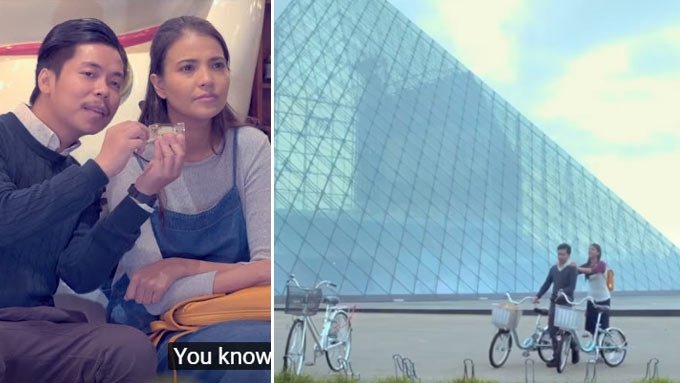Imagine yourself getting engaged for two years and then finding out that your fiancè wasn’t true to his colours. On this very doom’s day, an ailment capsizes the boat of your life. And then comes somebody who not only helps you in turn over the boat called life but helps you sail it in the right direction. “Kita-Kita”, a Filipino word for “I See You” is all about bringing tears to your eyes and providing warmth to your heart.
Director: Sigrid Andrea P. Bernardo
Cast: Alessandra De Rossi (Lea), Empoy Marquez (Tonyo), Junpei Yamamoto (Nobu), Carolle Urbano (Aiko)
OTT: Netflix
Lea, a Filipino (belonging to the Philippines) is a tour guide in Sapporo, Japan. She is head over heels in love with Nobu, her Japanese fiancè. Eventually, she has developed a one-track mind, only and only about tying a knot with Nobu. However, Nobu has different plans.
One day, Lea receives a note which she thinks Nobu. On visiting that place, she discovers Nobu flirting with her own friend, a Filipino-Japanese woman named Aiko. After having witnessed her Japanese fiancé’s infidelity, we expect Lea to go mad. But at this very moment, the audience sees how the movie breaks the fourth wall. Before venting out her anger, Lea counts slowly from one to ten and recalls all the happy memories she and Nobu had shared with each count. The moment is heart-wrenching yet absorbing.
As she walks out, stress-induced blindness occurs and she collapses. After a while, a fellow Filipino Tonyo makes a sudden appearance and tries befriending her by bringing her breakfast for his “countryman”. However, Blind Lea is in self-pity mode. But Tonyo is persistent and brings into limelight his charmer side. Using humour and kindness, he makes a connection with Lea

It all starts with a tour. The two spend most of their time travelling around tourist spots in Sapporo, with Tonyo serving as Lea’s eyes through all of their moments amidst giggles and mild flirting.
While soft music plays, Tonyo unwinds a music box for Lea telling her that every single beat this music box produces is worth the effort put in unwinding it.

Comical Tonyo doesn’t throw cheesy lines at the audience but tends to create a comfort zone for them. During the tour, Lea tells Tonyo how she got blind and if not recovered, she will turn blind permanently. At this very moment, Tonyo says the very iconic dialogue: “I See You”, deciphering the hidden meaning of the Japanese word Ashiyu (a Japanese public bath facility).
Eventually, they fall in love and make a promise to re-visit all the places they went to as soon as Lea regains her eyesight.

They later celebrate a pseudo-wedding where Tonyo gives Lea a Daruma doll — a Japanese doll which is believed to fulfil the wishes of the person who fills out its eyes.

Seeing almost 75% of the film, I had expected either of the two things to occur: the first one being a typical happy ending with Lea getting her eyesight back. Second, Tonyo will end up donating his eyes. However, to my utter surprise, nothing of this sort happens.
During one of their dates, Tonyo leaves Lea by the road to fetch a stuffed toy he intended to give Lea. At this point, Lea begins to regain her sight and, for the first time sees Tonyo waving at her from the other side of the road. A vehicle hits Tonyo who out of a pleasant surprise was dashing to Lea. Tonyo dies.
FORETELLING ALERT: Love Story ends!
But the director had different plans.
Lea had helped Tonyo when he came to Sapporo with a broken heart and a beer can. It’s a thunderclap to see how Tonyo was a part of Lea’s life even before they both had met. He was a drunken man who slept on the street in front of Lea’s home. She provided him with stir-fried cabbage for food since she believed that cabbage makes one happy and took care of him. Touched by her benevolence, he vowed to better himself and moves to a house right across from Lea’s. He watches Lea for a week and even sees her getting her heartbroken by Nobu. It was Tonyo who had left that note for Lea since he wanted her to know about Nobu’s infidelity. He was the one who carried her home after she collapsed the night she lost her sight.
The letter further expounds how once a feeling-blue Lea — wearing a giant heart suit — spends time instead with a banana mascot instead of Nobu. This banana mascot bearer unbeknownst to her was also Tonyo. Tonyo had an incurable heart problem since he was nine. Before succumbing to this, he promised the moon to Lea.
Lea fulfils her promise by re-visiting all the places she and Tonyo had been to. She puts on a blindfold in every place. We see Tonyo bringing out Lea in the best possible ways in the climax.
In plain view, Kita-Kita brings home the message of creating the very opportunity of leading a beautiful life amidst chaos and crisis.
Read here | ‘DOLLY, KITTY AUR WOH CHAMAKTE SITARE’ IS A MOVIE WITH ITS HEART IN THE RIGHT PLACE
